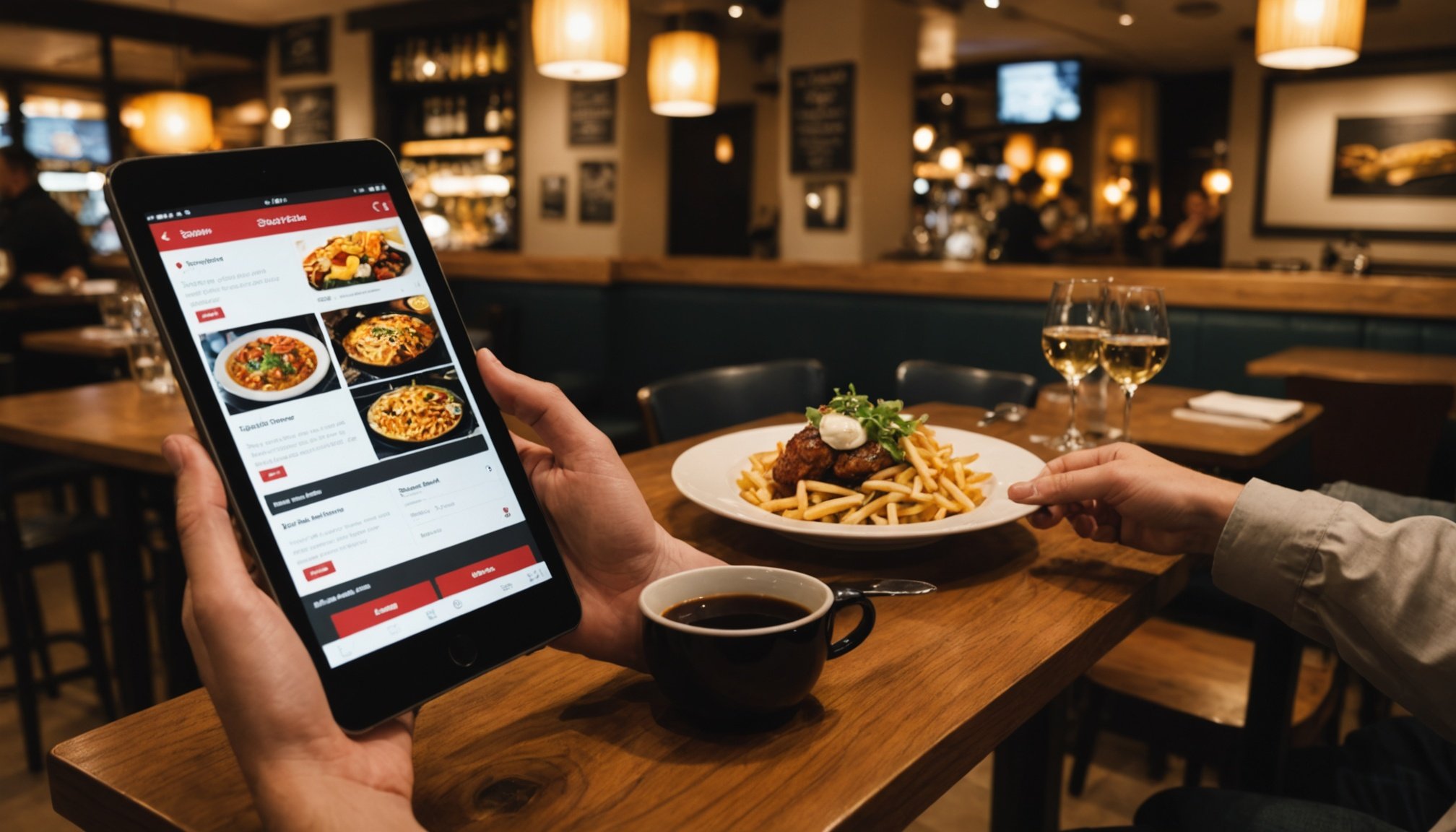Revolutionizing Dining: How Digital Menus Are Enhancing Customer Experiences in UK Restaurants
The restaurant industry has undergone significant transformations in recent years, and one of the most notable changes is the widespread adoption of digital menus. This shift has not only streamlined operations for restaurant owners but has also significantly enhanced the dining experience for customers. Here’s a deep dive into how digital menus are revolutionizing the way we dine in UK restaurants.
The Rise of Digital Menus
The COVID-19 pandemic accelerated the adoption of digital technologies in the restaurant industry, and digital menus were at the forefront of this change. What started as a necessity to replace paper menus for hygiene reasons has now become a staple in many UK restaurants.
Also to see : Maximizing donor engagement: creative strategies for uk nonprofits to harness mobile apps
QR Code Revolution
One of the most common forms of digital menus is the use of QR codes. These codes, often printed on tables, allow customers to access the menu on their smartphones. This technology assumes a certain level of tech literacy and smartphone ownership, but it has proven to be highly effective.
“Before COVID, the cleaning of things was done discreetly, behind closed doors, to make the service feel more seamless,” said Jonathan Kleeman, group beverage manager and executive head sommelier at Tom Sellers Story Group. “After COVID, it not only became more acceptable but even encouraged to visibly showcase the level of cleanliness, and QR codes have been a part of this transparency”[1].
Additional reading : Harnessing government incentives: a comprehensive roadmap for uk renewable energy companies to seize growth opportunities
Here are some key benefits of QR code menus:
- Convenience: Customers can easily access the menu without the need for physical contact.
- Real-Time Updates: Menus can be updated in real time, ensuring that customers always see the latest offerings.
- Ordering and Payment: Many QR code systems allow customers to order and pay directly through their smartphones.
- Environmental Impact: Reduces the need for paper menus, contributing to a more sustainable dining experience.
Enhanced Customer Experience
Digital menus are not just about convenience; they also play a crucial role in enhancing the overall customer experience.
Personalized Interactions
With digital menus, restaurants can offer personalized interactions that cater to individual customer preferences. For instance, using analytics tools, restaurants can track customer behavior on their digital menus to understand what items are most popular and how customers navigate the menu.
“Utilise analytics tools to track customer behaviour on your digital menu. What are customers clicking on? How long are they spending on each page? Understanding these patterns can help you optimise the menu layout and emphasise high-performing items,” advises UrbanPiper[3].
Real-Time Feedback
Digital menus allow for real-time feedback, enabling restaurants to make immediate adjustments based on customer responses. This can include monitoring online reviews and customer surveys to refine menu items and improve customer satisfaction.
“Monitoring online reviews on platforms like Google, Zomato, Deliveroo, Ubereats and social media is crucial. Pay attention to what customers are saying about your menu items. If there are recurring comments about certain dishes, take them into account. Positive feedback can help you highlight strengths, while constructive criticism can guide improvements,” suggests UrbanPiper[3].
The Role of Social Media and Mobile Apps
Social media and mobile apps have become integral to the digital dining experience, particularly in enhancing customer engagement and driving sales.
Social Media Influence
Social media platforms are no longer just for socializing; they have become powerful tools for restaurants to influence customer choices. According to recent statistics, 50% of diners claim that social media can influence their restaurant choices, and 22% of customers are inspired to revisit a restaurant due to its social media presence[2].
“50% of diners claim that social media can influence their restaurant choices. Also, roughly 22% of customers are inspired to revisit a restaurant due to its social media presence,” highlights Menu Tiger[2].
Here are some ways restaurants can leverage social media:
- Engaging Content: Share high-quality food photos, behind-the-scenes content, and customer testimonials.
- Promotional Deals: Offer exclusive discounts and promotions to followers.
- Customer Service: Respond promptly to customer feedback and queries on social media.
Mobile Apps and Digital Signage
Mobile apps and digital signage are transforming the way customers interact with restaurants. Mobile apps provide a direct path to the food customers want, while digital signage enhances the in-restaurant experience.
“Mobile apps are becoming the centerpiece of the QSR experience. For consumers increasingly looking for convenience, apps provide a direct path to the food they want and a mechanism for ultimate control,” explains QSR Web[5].
Here’s how mobile apps and digital signage are making a difference:
- Convenience: Mobile apps allow customers to order and pay online, reducing wait times.
- Personalization: Digital signage can display personalized messages and offers based on customer data.
- Real-Time Updates: Digital menus and signage can be updated in real time to reflect changes in menu items or promotions.
Self-Service Kiosks and Automation
Self-service kiosks and automation technologies are also on the rise in UK restaurants, particularly in fast food and casual dining sectors.
The Rise of Self-Service Kiosks
Self-service kiosks have become common in many UK restaurants, especially among fast food chains like McDonald’s, Subway, and KFC. These kiosks allow customers to order and pay without interacting with staff, which can reduce labor costs and streamline the ordering process.
“Even small fast-food restaurants and takeaways in London, some with only 20 seats, use self-service kiosks or screens where you place your order, even though you’re just a few feet away from the person at the till,” noted Jonathan Kleeman[1].
Here are some benefits of self-service kiosks:
- Efficiency: Faster ordering and payment processes.
- Cost Savings: Reduced labor costs.
- Customer Preference: Many younger customers prefer ordering through screens rather than interacting with staff[4].
Practical Insights and Actionable Advice
For restaurant owners looking to adopt digital menus and other digital technologies, here are some practical insights and actionable advice:
Update Your Menu Regularly
Updating your digital menu regularly is crucial to keep the dining experience fresh and engaging. Here’s a suggested approach:
- Quarterly Updates: Update your menu quarterly to strike a balance between consistency and variety[3].
- Use Analytics: Use analytics tools to track customer behavior and optimize your menu layout[3].
Leverage Social Media
Social media is a powerful tool for engaging customers and driving sales. Here’s how you can leverage it:
- Create Engaging Content: Share high-quality content that showcases your food and behind-the-scenes moments[2].
- Engage with Customers: Respond promptly to customer feedback and queries on social media[2].
Invest in Mobile Apps
Mobile apps can significantly enhance customer convenience and engagement. Here’s why you should invest in one:
- Convenience: Allow customers to order and pay online, reducing wait times[5].
- Personalization: Use customer data to offer personalized messages and offers[5].
The adoption of digital menus and other digital technologies has revolutionized the dining experience in UK restaurants. From QR code menus to self-service kiosks and mobile apps, these innovations have enhanced customer convenience, personalized interactions, and overall satisfaction.
As the hospitality industry continues to evolve, it’s clear that digital technologies will play a central role in shaping the future of dining. By embracing these changes and leveraging the insights and tools available, restaurant owners can ensure they remain competitive and continue to deliver high-quality dining experiences.
Table: Comparing Traditional and Digital Menus
| Feature | Traditional Menus | Digital Menus |
|---|---|---|
| Updates | Manual updates required | Real-time updates possible |
| Convenience | Physical menus need to be handed out | Accessible via QR codes or mobile apps |
| Feedback | Feedback collected manually | Real-time feedback through analytics and reviews |
| Personalization | Limited personalization options | Personalized interactions based on customer data |
| Environmental Impact | Paper waste | Reduced paper usage |
| Cost | Printing and distribution costs | Initial setup costs, but long-term savings |
Detailed Bullet Point List: Benefits of Digital Menus
-
Convenience:
-
Easy access to menus via QR codes or mobile apps.
-
No need for physical contact with menus.
-
Customers can order and pay online.
-
Real-Time Updates:
-
Menus can be updated in real time to reflect changes in offerings.
-
Immediate adjustments can be made based on customer feedback.
-
Personalization:
-
Analytics tools can track customer behavior to optimize menu layout.
-
Personalized messages and offers can be displayed based on customer data.
-
Environmental Impact:
-
Reduced paper usage contributes to a more sustainable dining experience.
-
Cost Savings:
-
Initial setup costs, but long-term savings on printing and distribution.
-
Potential labor cost savings with self-service kiosks.
-
Customer Satisfaction:
-
Real-time feedback mechanisms improve customer satisfaction.
-
Personalized interactions enhance the overall dining experience.
-
Engagement:
-
Social media integration can increase customer engagement and drive sales.
-
Mobile apps provide a direct path to the food customers want, enhancing convenience and control.











